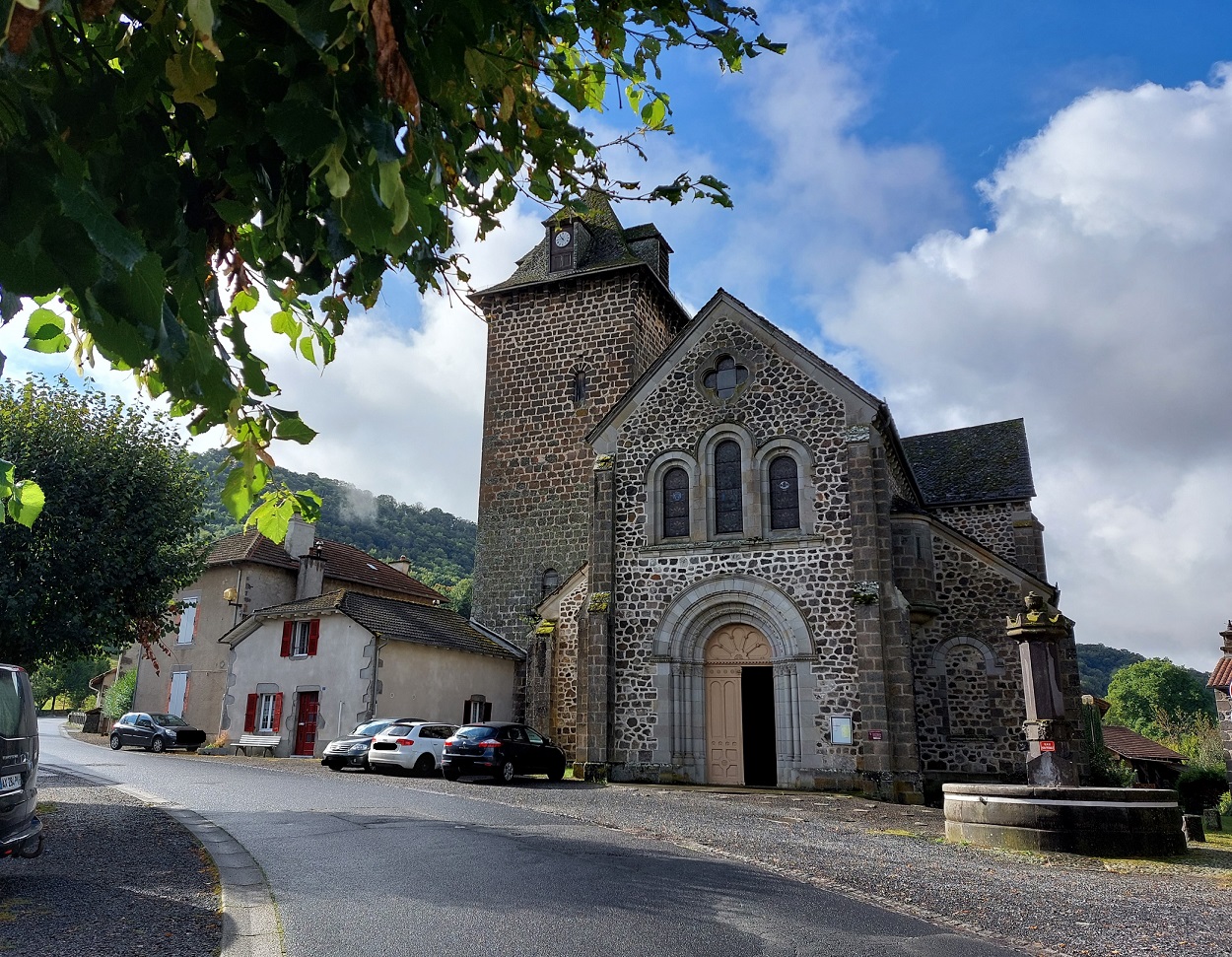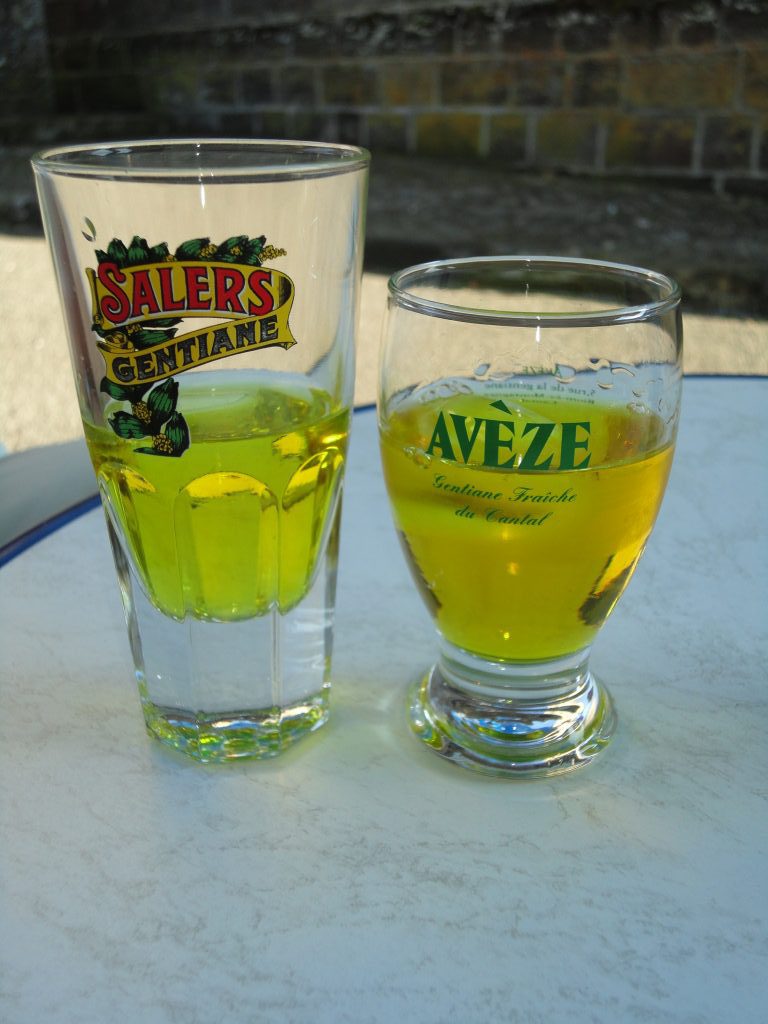I have been a bit AWOL from the blog for a couple of weeks, but there’s a good reason for that. We have been getting our annual fix of the Cantal, the mountainous region in South-Central France just over two hours’ drive from us.
Millions of years ago, this stunningly beautiful area was a gigantic volcano, the biggest in (what is now) Europe. It has left its mark in conical peaks and dark volcanic rock. Glaciers later gouged out valleys and hollows and left piles of boulders in their wake. Today, it’s pasture for woolly, long-horned Salers cattle and a paradise for walkers.
Maurs
This time, we explored the Jordanne Valley, one of two parallel river valleys that run South-Westwards. The other is the Cère. On the way, we stopped off in Maurs, which we normally drive through. This small town once fancifully labelled itself “the Nice of the Cantal”. Presumably, someone found this a bit OTT, so it became “Maurs-la-Jolie”.
Maurs is an attractive place, with half-timbered buildings, hidden squares and an imposing church. There’s probably a lot more to it than we saw, but after a coffee and a wander around, we were on our way.
Jordanne Valley
Our destination was the village of Saint-Cirgues-de-Jordanne, where we stayed again at La Maison Normande, a lovely chambres-d’hôtes that we discovered last year. Sarah and Tim have created a really special place to stay. In addition to delicious food, you get plenty of advice about walking and things to see.
Four French people were also staying, and we struck up daily conversations about our exploits.
The Jordanne Valley is wilder than its sister valley, the Cère, through which the main road from Aurillac to Clermont-Ferrand runs. The Puy Mary, the centre of the former volcano, acts as a natural barrier at the end of the Jordanne Valley. A pass, le Pas de Peyrol, exists over the top, but this is closed from the first snowfall, when it becomes impassable. Then, the upper valley is blanketed in snow and the peaks are difficult to access.
A string of pretty villages sits along the Jordanne River, each with its own charms. We made a point of exploring some of them, Tim and Sarah having pointed us towards various interesting features, which we wouldn’t have found otherwise.
Saint-Simon
The church here is not very old, dating from the early 20th century. However, it houses fascinating frescos. Legend has it that a young shepherd, Gerbert, who was born in a nearby hamlet, became a monk and then one of the most erudite men in Europe. He rose up through the church hierarchy to become Pope Sylvestre II at the end of the 10th century – the so-called Millennium Pope.
The frescos celebrate the life and career of Gerbert. He had a hand in the creation of the Hungarian monarchy, and the frescos were painted by a Hungarian painter, Gabor Szinte, in 2003-04. For me, they are reminiscent of the frescos in la chapelle des Treize Pierres in Villefranche-de-Rouergue, painted by the Estonian artist Nicolaï Greschny.
There’s another curiosity in Saint-Simon: a tilleul (lime tree) planted in c. 1600, which is still going strong. This is one of the so-called “Sully” trees, planted at the behest of Henri IV’s First Minister. There’s a story behind all this, so I’ll save that for a future post.
Lascelles
A meander up the valley took us to Lascelles, the village just before Saint-Cirgues. Here, a delightful 12th-century Romanesque church sits on a grassy knoll with views over the lush countryside. Far below, the Jordanne purls along through its gorges, which continue for a few km, although most of the Jordanne does not flow through deep canyons.
While we were there, midday struck in the bell tower, a clocher en peigne (built like a comb), which are common in Cantal. You can hear the bells of Lascelles (good title for a song) from Saint-Cirgues. Interestingly, they seemed to start a few seconds after those of the church in Saint-Cirgues itself.
Saint-Julien-de-Jordanne
With its twin village, Mandailles, this is the last proper village before the Puy Mary, apart from a couple of hamlets.


We parked and walked into the village. A man sitting on a bench outside his house hailed us and started a conversation that continued for a good half-hour. His name was Pierrot (diminutive of Pierre), and he had lived in the village for all of his 86 years, apart from a spell as a soldier in Algeria.
Pierrot’s house used to be the village épicerie (grocer’s shop). There is even an old petrol pump outside, so presumably it was the local petrol station as well. He had written a history of the village, which he showed us, and he was clearly greatly attached to his little corner of paradise. We asked him about the village school, which he said closed finally in 1986 for lack of children.
We all bemoaned the pressures of modern life and the abandonment of the countryside. He invited us to stay for a drink, but we had to be on our way.
Meeting people like that is one of the highlights when we visit a place.
Walking
I can’t finish without saying something about the walking, which is mostly what we were there for. The Jordanne Valley is full of randonnées, long and short, difficult and less difficult. Nearly all involve some tough uphill (and downhill) walking. We know that it’s sensible to pace oneself and not be too ambitious.
Sometimes we walked in forests of beech, with fallen beech mast crunching underfoot. Other times, we were above the treeline, treading on springy turf and surrounded by peaks with soft breezes whisking our hair. Wherever we went, the sound of cowbells accompanied us and the occasional shriek of a bird of prey.
La cerise sur le gâteau was seeing a marmot. These large rodents are herbivores and part of the squirrel family. They are active in summer, when they build up fat for winter hibernation underground.
Typically, we would have passed by without seeing it. A group of people were standing watching something. We made to go past them.
“Have you seen the marmot?”
“What marmot?”
“Over there on that mound.”
Sure enough, a brown furry creature was sunning itself and surveying the countryside. I was just about to take a photo when it hopped over the mound and disappeared. Our brief glimpse was magical.
I’ll leave you with some views of this Paradis Terrestre. There’s more to come.
Useful links
Pays de Salers Office de Tourisme
You might also like these related posts:
Copyright © Life on La Lune 2023. All rights reserved.

























Hi Vanessa – this reminds me that I really want to go back to this area and spend more time there . Perhaps I’ll start planning right now….
MJ
LikeLiked by 1 person
We have been countless times and never tire of it. Best times are either late spring or early autumn, the weather usually being more settled in autumn. Yes, carpe diem!
LikeLike
Thank you for this. We spent two weeks in the Cantal in June and it was wonderful. Unfortunately we did not get down to the Jordanne valley, but it looks gorgeous. We were further north about 11kms from Murat near the village of Neussargues. The Cantal was just beautiful with wild flowers and we loved the plateaux. We did visit the church in Cheylade as well as a couple of other chapels on hills.
https://www.tripadvisor.com.au/ShowTopic-g187070-i12-k14503574-Country_Roads_Less_Travelled_Weeks_7_8_The_Cantal-France.html#118559469
Makes me want to return.
LikeLiked by 1 person
I’ve read your interesting post on TripAdvisor. I didn’t realise you posted there, so I will go back and look at the others. We also like Murat and visited this time as well. June is a good time to visit Cantal, since it’s not too hot, and the wild flowers are abundant. Next time you come to France, the Jordanne Valley should be on your list!
LikeLike
ps our cycling son’s website…some of his words are delicious! 😊
LikeLiked by 1 person
Thanks. I will go and take a look.
LikeLike
Thank you for reminding me of a valley we have spent a little time in, introduced to us when being the broom wagon for our cycling son and our return to stay in the campsite with our new tent. The camping is over now for us as is walking until my husband makes a full recovery, fingers crossed. But places to visit in such a beautiful valley will be added to the bucket list. Our cyclist son still loves cycling to Puy Mary and did it again this summer as part of his randonneur around the year challenge (a 200km ride once a month!). It remains one of our favourite places close to ‘our’ river, le Cere.
LikeLiked by 1 person
There’s a surprising amount to see in the Jordanne Valley. But for our chambres d’hôtes owners, we’d never have found the frescos, which are strangely under-publicised. We saw a lot of cyclists in the valley. It’s certainly a challenge!
LikeLiked by 1 person
How evocative! Made me ponder a return some day…
LikeLiked by 1 person
Cantal is generally beautiful, but that valley in particular is worth visiting. I hope you’ll come to see us if you do.
LikeLike